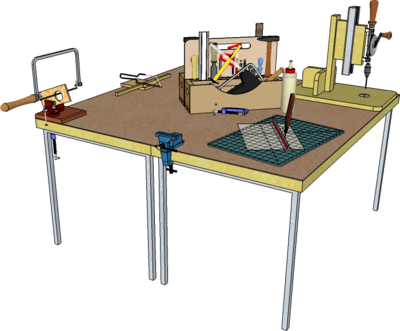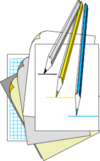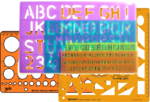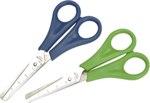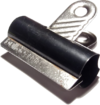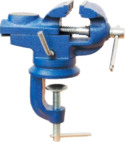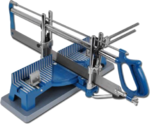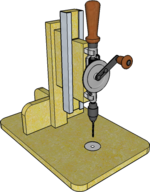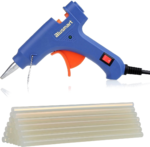Primary D&T Toolkit
From DT Online
Introduction
A wide variety of Design and Technology activities are possible with little additional tools and equipment. Resources should be well organised and labelled however, and sufficient regular time allocated to develop skills in their use, so that children can take some responsibility for their own learning.
Properly supervised and managed, Design and Technology provides safe and enjoyable activities for young children who gain much from the experience.
In the interests of safety, it is important to organise D&T resources such it is clear which tools and equipment are:
- available for general use;
- can be used only with direct adult supervision
- provided for adult use only
Tools to Use
These should be on open display (e.g. on a Shadow Board and labelled to help children know the correct names of what is available to use and what they can be used for).
| Pencil | Use a 2H pencil for marking out and a softer HB pencil for sketching. | |
| Rule | Used for measuring an drawing lines but also as a guide when creasing and folding paper or card. | |
| Pencil Compass | For drawing circles but can also be used for 'stepping off' equal distances and transferring a measurement (i.e. as a pair of Dividers) | |
| Templates | Commercially available for drawing common shapes, symbols and lettering but can also be home-made for a particular purpose. | |
| Scissors | Use round-tip scissors for safety and do not use scissors to pierce holes in card. Blades for corrugations and other shaped edges are available to make decorative cuts. | |
| Junior Hacksaw | All tools must be used with care but these can be quite safe for even young children to use, provided that: a metal cutting blade is fitted (i.e. not the coarser toothed wood cutting blades); the work is held firmly (i.e. in a small vice for younger children); and children are taught to keep both hands on the saw. | |
| Paper Punch | A single hole punch is the most useful for Design and Technology for any can be used (e.g. to make axle holes in card). Use upside down so it can been seen where the hole is to go. | |
| Handled Twist Drill | An ordinary twist drill (i.e. metal cutting : not wood cutting with sharp 'spurs') can be set into a file handle and used to 'ream out' previously drilled holes. Mini Hand Drills are also available which grip a single twist drill for this purpose. | |
| Pegs | Spring operated clothes pegs can be used to hold work together as glue dries and wooden pegs can be glued to chassis to create axle holders. | |
| Bulldog Clips | Used to hold work together as glue dries. | |
| Paper Clips | Used to hold work together as glue dries but also in combination with drawing pins to make simple electric switches. | |
| Weights | Used to hold work together as glue dries and to test structures (Safety Point! If heavy weights are needed to test a structure use a bag or plastics bucket and sand not sharp-edged metal weights.) | |
| Clamp-on Vice | A more secure means of holding work whilst sawing and especially easiest for younger children. | |
| Bench Hook | A quick and convenient method of supporting strips of wood whilst sawing to length - more suitable for older pupils. | |
| G Cramp | A range of smaller sizes are useful for securing equipment such as Hand Drill Stands and Precision Mitre Saws to the work-surface. | |
| Drawing Pins and Paper Fasteners | Can be used as pivots or to make electrical contacts (e.g. for switches) in simple circuits. | |
| Stapler | Can be used to hold together card structures either permanently or temporarily as glue dries (e.g. when making the card hull of a Viking Boat). | |
| PVA Glue | A safe adhesive for paper, card, wood and other porous surfaces (i.e. not painted or varnished). | |
| Double Sided Tape | Can be used to hold together flat surfaces - even if they are plastics, painted or varnished. | |
| Foam Sticky Pads | Can be used to locate objects - even if they are plastics, painted or varnished. |
Tools to Ask For
Although not overly dangerous, young children may need help using these tools: they may be too heavy for them to handle easily or will require some setting up. They can be displayed on their own Tool Boards or stored in separate Tool Caddies and brought out as needed
| Coping Saw | Used with work held in a vice and both hands on the handle, they are reasonably safe for children to use but, because of their relatively coarse teeth and danger of blade breaking, some supervision is advised. | |
| Precision Mitre Saw | A relatively large piece of equipment that children will need help setting up to cut to length or to an angle, larger sections of timber. | |
| Hand Drill Jig | A relatively large piece of equipment that children will need help setting up and organising to work in pairs to operate. |
Tools for Adult Helpers
These tools are dangerous: then can cause cuts and burns! Adult helpers may need them when working with young children and older children may be able to use them under close one-to-one supervision. This equipment can be stored in separate Tool Boxes and secured in a storeroom or cupboard until needed.
| Craft Knife | These are extremely sharp and must only be used in conjunction with a Safety Ruler and Cutting Mat either by an adult helper or by older pupils under very close one-to-one direct supervision. | |
| Glue Gun | Low-Melt glue guns are available but these too can cause burns and so used either by an adult helper or by older pupils under very close one-to-one direct supervision. | |
| Soldering Iron | Hot enough to melt solder and therefore will cause burns and may generate harmful fumes, therore used only by an adult helper or by older pupils under very close one-to-one direct supervision in a well-ventilated area. Choose a soldering iron with burn-proof silicone cable. (Note: Conductive glue is available and may be an alternative to soldering in some instances.) |
- The tools and equipment listed assumes the existence also of commonly available classroom resources such as: basic geometry equipment (e.g. pencils, rulers, compasses); pencil sharpeners, artists' brushes or glue spatulas, paper punches and trimmers, paper clips, bulldog clips, PVA glue.
See also the Buyers Guides for:
 |
 |
 |
 |
 |
 |
 |
 |
 |
| Combination Pliers |
Pistol Grip Junior Hacksaw |
8oz Claw Hammer |
Cross Pein Pin Hammer 4oz |
Clamp on Bench Vice |
Coping Saw Frame |
Glue Gun |
Soldering Station |
Flip-Top Workbench |
